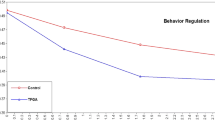Abstract
The 5-year annual and 4-year follow-up results of a collaborative community mental health center-junior high school program for disruptive students are presented. The program is a comprehensive, behavioral, in-school, regular education project characterized by a token economy, parent contracting, major subjects taught in the morning, small class enrollment, small group and individualized instruction, an early release from school contingency option and frequent parent-school communications. Annual controlled outcome results revealed that the program led to significant and consistent reductions in expulsions, suspensions, and grade failure, and variable, often significant, gains in attendance and achievement. Follow-up findings indicated that former program students in senior high school achieved a significantly higher entry rate, greater attendance, better classroom conduct, and a lower frequency of withdrawal from school.
Similar content being viewed by others

References
Ahlstrom, W. M., & Havighurst, R. J.400 losers: Delinquent boys in high school. San Francisco: Jossey-Bass, 1971.
Berleman, W. C., Seaberg, J. R., & Steinburn, T. W. The delinquency prevention experiment of the Seattle Atlantic Street Center: A final evaluation.Social Service Review, 1972,46, 323–346.
Cohen, S. L., Keyworth, M., Kleiner, R., & Brown, W. Effective behavior change at the Anne Arundel Learning Center through minimal contact intervention. In R. Ulrich, T. Stachnik, & J. Mabry (Eds.),Control of human behavior (Vol. 3). Glenview, Illinois: Scott, Foresman, 1974.
Friedman, R. M., Filipczak, J., & Fiordaliso, R. Within school generalization of the Preparation Through Response Education Programs (PREP) academic project.Behavior Modification, 1977,8, 986–995.
Garibaldi, A. (Ed.).In-school alternatives to suspension: Conference report. Washington, D.C.: National Institute of Education, April 1979.
Heaton, R. C., & Safer, D. J. Secondary school outcome following a junior high school behavioral program.Behavior Therapy, in press.
Heaton, R. C., Safer, D. J., Allen, R. P., Spinnato, N. C., & Prumo, F. M. A motivational environment for behaviorally deviant junior high school students.Journal of Abnormal Child Psychology, 1976,4, 263–275.
Jastak, J. F., & Jastak, S. R.The wide range achievement test. Wilmington: Guidance Associates of Delaware, 1972.
Kent, R. N., & O'Leary, K. D. A controlled evaluation of behavior modification with conduct problem children.Journal of Consulting and Clinical Psychology, 1976,44, 586–596.
Long, J. D., & Williams, R. L. The comparative effectiveness of group and individually contingent free time with inner-city junior high school students.Journal of Applied Behavioral Analysis, 1973,6, 465–474.
National Institute of Education.Violent schools-safe schools: The safe schools study report to Congress (Vol. 1). Washington, D.C.:January 1978.
Reckless, W. C., & Dinitz, S.The prevention of Juvenile delinquency: An experiment Columbus: Ohio State University Press, 1972.
Safer, D. J.School programs for disruptive adolescents. Baltimore: University Park Press, 1982.
Trice, A. D., Parker, F. C., Safer, D. J., Iwata, M. M., and Marriott, S. A.Teaching bad boys: Perspectives on an in-school program for disruptive adolescents. Baltimore: American Young Company, 1981.
Author information
Authors and Affiliations
Additional information
One second cohort student had been advanced a grade and was thus added to the original first cohort of 14 students.
Rights and permissions
About this article
Cite this article
Safer, D.J., Reaton, R.C. & Parker, F.C. A behavioral program for disruptive junior high school students: Results and follow-up. J Abnorm Child Psychol 9, 483–494 (1981). https://doi.org/10.1007/BF00917797
Revised:
Issue Date:
DOI: https://doi.org/10.1007/BF00917797



